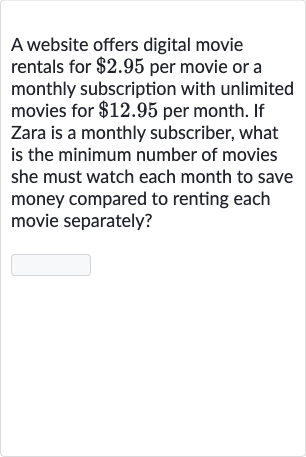AI tutor
Welcome to Bytelearn!
Let’s check out your problem:

A website offers digital movie rentals for per movie or a monthly subscription with unlimited movies for per month. If Zara is a monthly subscriber, what is the minimum number of movies she must watch each month to save money compared to renting each movie separately?
Full solution
Q. A website offers digital movie rentals for per movie or a monthly subscription with unlimited movies for per month. If Zara is a monthly subscriber, what is the minimum number of movies she must watch each month to save money compared to renting each movie separately?
- Comparison of Costs: We need to compare the cost of renting movies individually with the cost of the monthly subscription to find the break-even point where Zara starts saving money.Let's denote the number of movies Zara rents as . The cost of renting movies individually is times . The cost of the monthly subscription is a flat rate of .
- Setting up the Inequality: Set up the inequality to solve for : We want to find the smallest integer such that \$2.95n > \$12.95.
- Dividing the Inequality: Divide both sides of the inequality by . to solve for :n > \frac{\$12.95}{\$2.95}.
- Finding the Value of : Perform the division to find the value of : n > 4.3898\dotsSince Zara can't watch a fraction of a movie, we round up to the next whole number.
- Rounding up to the Next Whole Number: Zara must watch at least movies to save money with the monthly subscription, as is the smallest whole number greater than .
More problems from GCF and LCM: word problems
QuestionGet tutor help
QuestionGet tutor help
